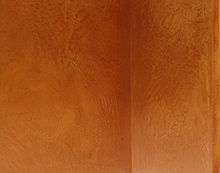Tadelakt

| Part of a series on |
| Arabic culture |
|---|
 |
Tadelakt (Moroccan Arabic: تدلاكت, romanized: tadla:kt) is a waterproof plaster surface used in Moroccan architecture to make baths, sinks, water vessels, interior and exterior walls, ceilings, roofs, and floors. It is made from lime plaster, which is rammed, polished, and treated with soap to make it waterproof and water-repellent.[1] Tadelakt is labour-intensive to install, but durable.[2] Since it is applied as a paste, tadelakt has a soft, undulating character, it can form curves, and it is seamless. Pigment can be added to give it any colour, but deep red is traditional.[3] It may have a shiny or matte finish.
Etymology and history
[edit]The term tadelakt, meaning "to rub in", is an Amazighified expression from the Arabic word تدليك tadlīk, meaning "to rub or massage."[3][4]
Tadelakt is thought to have evolved from qadad, a similar plaster used in Yemen for millennia that is treated with calcium hydroxide and oils and fats instead of soaps.[2]
Constituents and chemistry
[edit]The basic constituents of tadelakt plaster are:
- lime plaster (not Portland cement)
- in some cases, marble or limestone sand (but not other aggregates)
- natural soap (often "black" or olive oil soap) to speed carbonation of the surface and impart water-resistance.
The soap chemically reacts with the lime plaster, forming lime (calcium) soaps. Calcium soaps are insoluble in water,[5] and fairly hard.[3] They are familiar, in areas with calcium-rich ("hard") water, as deposits in bathtubs, sinks, and showers; when soap is mixed with the water's dissolved calcium carbonate/lime, calcium soaps form.
- 2 C17H35COO−Na+ + Ca2+ → (C17H35COO)2Ca + 2 Na+
Techniques
[edit]
Traditional application includes polishing with a river stone and treatment with oleic acid, in the form of olive oil soap, to lend it its final appearance and water resistance.
In Morocco, the traditional application technique:
- plaster powder is mixed with water for 12 to 15 hours prior to the addition of pigment.
- the plaster is applied in one thick coat with a wooden float, and smoothed with the same.
- before the plaster sets, a flat, smooth, hard stone is used to compress the plaster, then a plastic trowel used for the final polish.
- it is mechanically polished using stones or abrasives harder than the plaster, providing a smooth, sometimes shiny, finish.
- lastly, an olive-oil soap solution is used to seal the plaster
Long-term maintenance of tadelakt requires regularly re-sealing the surface with a soap solution;[3] in the case of qadad roofs, this was traditionally done every few years.[2]
Uses
[edit]
Tadelakt is the traditional coating of the hammams and bathrooms of palaces and riad residences in Morocco.[6] The restoration of riads in Morocco has led to a resurgence in its use.[citation needed]
In modern times, it has been used outside.[7]
See also
[edit]- Earthen plaster
- Polished plaster
- Plasterwork
- Sarooj, a similar water-resistant plaster
- Zellige
- Stucco
References
[edit]- ^ Wolff, Britta (2013). "Hydrophobized Lime Plasters as Protective Surface in Wet Rooms in Monument Preservation". Advanced Materials Research. 688: 60–69. doi:10.4028/www.scientific.net/AMR.688.60. S2CID 109703139.
- ^ a b c Anita Sutter, « Note sur la fabrication du qadâd », Chroniques yéménites [En ligne], 6-7 | 1999, mis en ligne le 18 décembre 2006, consulté le 13 février 2016. URL : http://cy.revues.org/111
- ^ a b c d Polak, Monique (1 September 2005). Home Invasion. Orca Book Publishers. ISBN 9781551434827 – via Google Books.
- ^ Team, Almaany. "تعريف و شرح و معنى تدليك بالعربي في معاجم اللغة العربية معجم المعاني الجامع، المعجم الوسيط ،اللغة العربية المعاصر ،الرائد ،لسان العرب ،القاموس المحيط - معجم عربي عربي صفحة 1". www.almaany.com. Retrieved 2019-05-11.
- ^ Graham, David Y.; Sackman, Jeffrey W. (1983). "Solubility of calcium soaps of long-chain fatty acids in simulated intestinal environment". Digestive Diseases and Sciences. 28 (8): 733–736. doi:10.1007/BF01312564. PMID 6872805. S2CID 19412236.
- ^ Wolff, Britta; Diederichs, Ulrich; Ait El Caid, Hassan (2014). "Non-Destructive Prospection of Ancient Steam Bathes Covered with Tadelakt — First Preliminary Comparison of Hammam Kasbah des Caids of Tamnougalt and Hammam Kasbah of Taourirt, Morocco". Advanced Materials Research. 923: 174–182. doi:10.4028/www.scientific.net/AMR.923.174. S2CID 109014106.
- ^ "Tadelakt Exterior stucco Vancouver - Venetian Plaster and Stucco - Vancouver BC". authenticplasterfx.com.
External links
[edit] Media related to Tadelakt at Wikimedia Commons
Media related to Tadelakt at Wikimedia Commons

